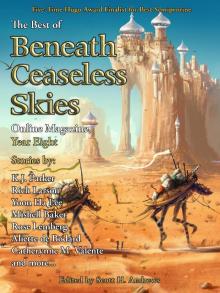


The Atlas of Middle-earth
Karen Wynn Fonstad
RAUROS Inset: AMON HEN
Between Sarn Gebir and the Argonath the river had eroded down sharply, so that cliffs rose “to unguessed heights on either side.”17 Nen Hithoel, the lake behind the natural dam of the southern ridge, also lay at the base of high cliffs. These cliffs had been eroded somewhat, and alluvial terraces were left at their feet, such as the lawn of Parth Galen and the “shelving shore” where Sam and Frodo hid their boat.18 South of the lake the river must have downcut through the ridge, leaving behind three hills. On the west and east were Amon Hen and Amon Lhaw, the Hills of the Eye and the Ear, with their battlemented summits and high stone seats of Seeing and Hearing. In the center, surrounded by rushing waters, stood Tol Brandir.19 Beyond that isle the three layers converged, forming the cliff over which Rauros pounded. So sheer was the drop that portaging was possible only by descending the ancient North Stair.20
As Aragorn, Gimli, and Legolas pursued the Ores, they climbed westward up the more gradual eastern slope, then down a deep valley on the west. At the base of the cliff a “dale ran like a stony trough between the ridge hills.”21 This valley marked the separation of the two major rock strata. The outer ridge conformed to the pattern of the inner. It had a gentle slope rising away from the creekbed and a steep escarpment facing the plains of Rohan.
East of Nen Hithoel, Sam and Frodo must have crossed the same layers, but differences in slope, some faulting, and other factors replaced the two distinct ridges and shelf of the western Emyn Muil with a “strange twisted knot of hills.”22 There was evidently a fault line at the eastern edge, highest in the south. Northward “the cliff-top was sinking towards the level of the plains.”23
Erosion and mass wasting probably made the tumbled land where the cliff had “slipped and cracked . . . leaving great fissures and long slanting ledges that in places were almost as wide as stairs.”24 Still, the end of the gully towered about 108 feet (eighteen fathoms),25 and most of Sam’s rope of “thirty ells, more or less”26 was required to help them escape the Emyn Muil at last.
THE HILL-LANDS Cross Section: NORTH-NORTHWEST TO SOUTH-SOUTHEAST
The White Mountains
THE SECOND MAJOR RANGE of mountains spanned some 600 miles, west to east. The White Mountains were present in the First Age1 and were quite likely raised at the same time as the Towers of Mist. Their northern arm even appeared to be an extension of that north-south range, merely eroded away at the Gap of Rohan. West of Dunharrow and south of Helm’s Deep, where the forces forming the east-west and the north-south ranges met, the land was heaved upward and tortuously twisted into a knot. There were probably some of the highest peaks in the known lands of Middle-earth (after the destruction of Thangorodrim and the Iron Mountains)—possibly even higher than those of the Alps. Many other portions of the White Mountains must also have been as high as most of the Misty Mountains, or higher, in order to remain snowcapped at the more southerly latitude. Tolkien’s contour-like lines on the map in The Return of the King gave the impression that Mt. Mindolluin and the Starkhorn were hardly higher than the heights of the Emyn Muil or the Ephel Dúath; yet those peaks were snowcapped, while the other highlands were not. Originally, Tolkien stated the White (then ‘Black’) Mountains were “not very high, but very steep on the north side.”2 At least the first part of this view must have changed, for to have been snowcapped they must have been at least 9500 feet in elevation.3 Also, either due to elevation or rugged topography or a combination of the two, there were apparently no passes, or Aragorn would not have been desperate enough to hazard the Paths of the Dead.
Landscape Morphology
Once again Tolkien gave clues that alpine glaciation had occurred in at least the area of Dunharrow. Starkhorn had a jagged peak with everlasting snow.4 Irensaga was “saw-toothed”5—an apt description of a series of jagged peaks formed by the heads of glaciers, or cirques, cutting back until they meet, forming arêtes. Even at this southerly latitude, glaciers had apparently extended into the main vale of the Snowbourn. It was deep, with steep sides, as any great mountain valley would have been. The clues indicating glaciation were the width of a “little more than half a mile” where Théoden’s riders crossed6 and the two tributary valleys that hung high above the floor of the main vale. The stream in the western valley ran in a “narrow gorge” and emptied over the cliff in “waterfalls,”7 so it was probably not glaciated, even though the main vale was. East across the river the road of Púkel-men slowly wound up the towering cliff “hundreds of feet above the valley” to the “wide upland . . . the Firienfeld.”8 The glen ran deep into the mountains until it ended at the “sheer wall” of the Haunted Mountain.9 This high dell was typical of a glaciated hanging valley—broad and long, with the glacier having scoured steep walls along the sides and shattered the rock at its head, forming a crowning amphitheater.10
Glacial landforms were not mentioned elsewhere in the range, although they may have been present—especially in the “knot.” Atypically, the Stonewain Valley was described as a “trough,” but its low elevation would indicate it was not glacial, so the term may have been applied loosely. The valley could have been stream-cut, although there was no stream there in the Third Age. It could have been a fault or a downfold, or it might not have been a natural feature at all but a colossal stone quarry, as implied by Ghân-buri-Ghân.11
Rock Type
Only two rock types can be identified in the White Mountains with any assurance: limestone (metamorphosed into marble in certain areas) and intrusive igneous. Soluble limestone was evident in the area of Helm’s Deep and can be inferred near Mt. Mindolluin, due to the proximity of limestone formations in the Emyn Muil, the Downs, and North Ithilien. The white walls of Minas Tirith were probably locally quarried limestone of resistant type. The Tower of Ecthelion that “glimmered like a spike of pearl and silver”12 may have been white marble.
The Glittering Caves of Aglarond were basically found in a soluble limestone layer. The formations were typical of extensive cavern systems—columns, wings, ropes, curtains, underground pools. Less common were the “gems, crystals and veins of precious ore,”13 which could have been the result of igneous intrusions. Some of the finest rubies and sapphires in our world are found as secondary deposits in solution cavities in northern Burma.14 No mention was made of any ore deposits elsewhere in the range, although the exclusion certainly does not mean they were nonexistent.
In contrast to Aglarond, the Paths of the Dead were as “dry as dust.”15 Dry caverns can occur as upper galleries, but no cavern-type formations were mentioned, so they probably were not solution cavities. Instead, they may have resulted from water, frost, or even lava enlarging existing cracks and joints, then evacuating the channel. The Paths may have resulted from any of these causes, or may even have been mined in whole or in part. The color clues in the area support the possibility of igneous rock, which is often black. The sunrise view revealed peaks that were “white-tipped and streaked with black,”16 and the Haunted Mountain was called “black Dwimorberg.”17
In spite of the predominance of white rock used in the construction of Minas Tirith, the hill itself may have been volcanic. The outer wall was the same invincible black rock as that forming Orthanc, and the “vast pier of rock” could easily have been a weather resistant ‘dike’ such as those sometimes found in extinct, eroding volcanic cones.18
The Lowlands
Arms of the White Mountains extended far to the south, some almost to the Bay of Belfalas. Between the ridges lay deep-cloven river valleys, such as that of the Morthond, where the Grey Company descended from the Paths of the Dead—“a great bay that beat up against the sheer southern faces of the mountains.”19 These alluvial valleys coalesced as they neared the bay, producing the fair green coastlands of Anfalas and Belfalas.
The broad plain north of the White Mountains and southeast of the Misty was entirely drained by one huge river system, that of the Entwash. Although it had its source in the springs leaping down Mount Methedras abo
ve Treebeard’s abode,20 most of its tributaries ran from the White Mountains. It would also have drained part of the south downs and the Wold through groundwater discharge. The Entwash had one unusual feature, the large inland delta. Such a formation might give the impression that the river was quite muddy, yet an inland delta is not indicative that a river carries large amounts of sediment. Instead, this pattern develops where there is a sudden decrease in slope from the extremely high mountains down to the flat valley bottom. The abrupt change sharply reduces the river’s ability to carry particles in suspension, and the accumulation of sediment that results disrupts the main river channel. This action is apparent in the Entwash from the braided stream shown above the delta.21 The breakdown of current further reduces the carrying capacity, causing more deposition. The rivulets wander farther, and the cycle continues until the adjustment has been made and the river reconsolidates itself or, as in the case of the Entwash, enters another river.
Prairie grasses normally occur in relatively dry areas; yet the plain must have been easily flooded. After the Long Winter it became “a vast fen,”22 and even in drier years Shadowfax led the way around “hidden pools, and . . . wide and treacherous bogs” between Fangorn and Edoras.23 Apparently there was just enough water to produce the marvelously lush grasslands of Rohan.
THE WHITE MOUNTAINS
Mordor (and Adjacent Lands)
TOLKIEN ONCE COMMENTED that Mordor corresponded more or less with the Mediterranean volcanic basin; and Mt. Doom, Stromboli.1 At every turn the volcanism was suggested: Mordor, the Black Land; Ephel Dúath, mountains of black rock; Ered Lithui, ash mountains; Lithlad, ash plain; Gorgoroth, a volcanic plateau; and of course, Mt. Doom, an active volcano. The landscape was sinister, in keeping with its master. The lands outside the Ephel Dúath (the “outer fence") were noticeably nonvolcanic: North Ithilien, a quick-falling land filled with streams and grottoes; marshlands; moors of the Noman-lands; and even Dagorlad, the hard battle plain. They, too, added to the mystique. The lands in the northwest, near the Morannon where Sauron’s power was strongest, fell under his power and were ruined; but Ithilien had only recently come under the evil influence and “kept still a dishevelled dryad loveliness.”2
The Adjacent Lands
The northern lands were swept by bitter eastern winds carrying fumes from the slag mounds and from the increasingly active Mt. Doom.3 The climate became arid, and the landscape was slowly denuded of its growing things. As the lands became more barren, the little rain that fell ran off the surface of the nearby highlands and fed more and more water into the bracken swamps. The Dead Marshes grew until they had swallowed up the graves dug after the battle of the Last Alliance.4
As Frodo and Company left the Dead Marshes they climbed “long shallow slopes” of the “arid moors of the Noman-lands.”5 These were probably the receding end of a sedimentary layer that continued south through Ithilien, dipping away from the Ephel Dúath. The edge of the sediments had eroded back from the range, leaving the “long trenchlike valley between it and the outer buttresses of the mountains” over which the Hobbits peered toward the Morannon.6
As the mountain chain turned east, the crest fell away, and the valley widened into a plain—Dagorlad, scene of many battles—over which the Hobbits watched the Southrons enter the Black Gate. The plain was “stony,” probably a pediment—the rubble of innumerable rocks washed out from the mountains, but never weathered due to the arid climate.7
The Hobbits turned south, following the path of the road that was built between the crests of the western slopes and the eastern mountains. They passed into an increasingly pleasant land, with ample rainfall blown in on the moist southwest winds from the Bay of Belfalas.8 There the water collected into numerous streams, which fell quickly down to Anduin, cutting steep gorges. Sometimes the streams found their way into a crevice and followed the weak fissures under the surface, reappearing far below in springs. One such “grot” was sealed to form Henneth Annûn.9 Farther south the sediments must have continued to dip steeply, for after leaving Faramir’s refuge the Hobbits stayed west of the road until they reached the gorge of the Morgulduin. Turning east, they climbed continually, and “if ever they went a little downward, always the further slope was longer and steeper.” At last they struggled “onto a great hog-back of land”10—a sharp-crested ridge of resistant sediments with a backslope exceeding 45° and an even steeper scarp.11 Beyond the Cross-roads lay the first “tumbled lands” of Mordor.12
Mordor
The land of Sauron was composed of three major features: the mountains, which were “parts of one great wall”; the plateau of Gorgoroth; and the plains of Lithlad.13 All the lands were arid and all were volcanic. Climbing the mountains, the Hobbits were surrounded by constant examples of the volcanic rock, which made the range predominantly black. Gabbros may have been thrust up; basalts extruded at lower levels or exposed in necks and dikes. All could have given the black appearance. Along the Winding Stair the Hobbits passed “tall piers and jagged pinnacles . . . great crevices and fissures . . .”14 These could have resulted from the columnar weathering of basalt.
Around them the peaks rose high above, but were apparently lower than those of the White and Misty Mountains. No mention was made of snow, although “forgotten winters had gnawed and carved the sunless stone.”15 Still, the peaks were probably quite high, for the top of the pass of Cirith Ungol was more than 3000 feet above the Cross-roads.16 Possibly the ranges could have been folded and faulted as well. Faulting probably produced the trough between the Ephel Dúath and the Morgai through which the Hobbits crept north from Cirith Ungol. “The eastern faces of the Ephel Dúath were sheer,” and the slopes of the Morgai were jumbled, notched, and jagged.17 Transverse faults were apparent too, for Sam and Frodo drank from a gully that appeared to have been “cloven by some huge axe.”18
At the north end of the Ephel Dúath, at its junction with the Ered Lithui, lay a deep circular valley ringed by sheer black barren cliffs—Udûn. Tolkien described the vale as being encircled by arms sent out by the two ranges.19 The symmetry of the valley suggests either a caldera or a ring-dike. A caldera is the remnant of a volcano that has exploded and/or collapsed. A ring-dike is a circular ridge of cooled igneous rock surrounding a deep valley. It occurs when a round block subsides into an underlying magma chamber and the fluid magma is forced up around the edges. Often the upwelling is intermittent, leaving passes such as the Isenmouthe and Cirith Gorgor.20 Either process could have resulted in the feature shown by Tolkien, although compared with our world either would have been gigantic. Imagine the original height of a volcano with a forty-five-mile base. This colossus would have towered almost 29,000 feet! In contrast Mt. Doom was only seven miles across and stood 4500 feet.21
As the Hobbits turned east and south from Udûn, they faced the final path across Gorgoroth, a lava plateau.22 Its level would have been higher than that of Udûn (a “deep dale") and the plain of Lithlad.23 Tremendously thick layers of flood basalts were deposited through the years by slow upwelling from the many fissures that pocked the landscape. These were supplemented by flows from volcanoes, most of which had previously been active but had left only the skeletons—necks and dikes, low mounds, and in the southeast where erosion was more advanced, mesas and buttes. At the time of the quest, fissures were numerous, and the remnants of activity gave the plateau its rugged and evil appearance;24 yet none was more imposing than the smoking peak at the very heart—Mt. Doom.
The plateau was barren, and had all Mordor been of that formation Sauron would have had little to feed his countless troops; but conditions were somewhat better in Lithlad—the ash plain. There the flows of more solid material were apparently less, or were mostly eroded. If the rock were highly weathered, the resulting soil would have been quite fertile. In the semi-arid climate, water was in short supply, for the bitter Sea of Nurnen (with its interior drainage) was salty.25 Still, a recent deposition of ash would have helped with conservation (for ash is a hig
hly effective mulch, reducing evaporation),26 allowing dry-land farming in the “great slave-worked fields.”27
Originally, the geography of Mordor was rather different, notably in the northwest. Gorgoroth was present from the beginning, but extended almost to the Sea of Nurnen, and only the eastern ridge with Barad-dûr at the end was shown.28 The Gap of Gorgoroth, which eventually was blocked by the fortress of the Morannon, was once the site of Cirith Ungol.29 The Vale of Udûn and the Isenmouthe, the ridge of the Morgai, and the eastern and western ranges separating Gorgoroth from Lithlad were all absent until late in the story.30 The near-encirclement of Gorgoroth and addition of Nurn to its south on The Lord of the Rings map left Lithlad in its original placement—east of Gorgoroth, south of the Ash Mountains.31 Even the southern Ephel Dúath were changed, originally bulging in two arcs nearly 150 miles wide toward Harad, and narrow only at the Nargil Pass, at the source of the southern river feeding into the Sea of Nurnen.32
MORDOR Cross Section Left: WEST-EAST Cross Section Right: NORTHWEST-SOUTHEAST
THE HOBBIT
Introduction
IN “THE HOBBIT” TOLKIEN provided some vivid descriptions, but stated few dates and no distances, and showed no scale on the original map of Wilderland. Therefore, the pathway maps could be drawn only by using the map scale and other information from The Lord of the Rings. The Shire Calendar explained the day/date system, which allowed analysis of the few dates given in The Hobbit.1 Once the number of travelling dates had been established, it was possible to calculate the miles covered daily by mere measurement, combined with occasional clues such as rising early, riding late, and factors that might have altered the company’s speed.














